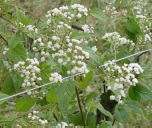– Victor Shelton, NRCS State Agronomist/Grazing Specialist

White snake root; either eaten in large amounts at one time or in small amounts over a period of time, both can be fatal. (Victor Shelton photo)
As I write this in early October parts of Indiana still remain dry with an intensity rating of abnormally dry to moderate drought. It’s certainly been drier in the past, especially thinking back to 2012, but we could benefit from some rain. Forage regrowth has slowed down and opportunities for fall annuals remains challenging.
I planted some annuals; they emerged but would greatly benefit from some precipitation in order to meet their purpose. If we get some rain, along with enough warm days for good growth, they may still provide some forage for grazing.
The earlier we can get those fall annuals up and growing, the more growth potential they have. If you haven’t planted any yet, your choices have narrowed down a lot and most potential for any fall grazing. Annual ryegrass, cereal rye, wheat, triticale, and winter peas are pretty much all that is left that still could be planted. If planted now, grazing opportunities will be more likely in the spring unless we have unusually warm weather.
The dry conditions not only impact fall planted annuals, but they will also impact regrowth and most likely, the amount of potential stockpile. We still have time to acuminate a fair amount of stockpile for winter if moisture is sufficient; no worries yet.
A question on irrigating pasture was brought up last week. Here in Indiana, there are typically only portions of three months where moisture may be lacking including July, August, and September. The first question to consider is the water source. It will take a very good one. One acre inch of water is a lot of water: 27,154 gallons of water, per acre! If you only add two acre inches of water per month multiplied by the number of acres you want to irrigate, that adds up to a huge amount of water. That can strain water reserves unless you have a huge lake or other water source to pull from. Below ground water reserves also have limits; we found that out the hard way in 2012. Whether you irrigate or not, maintaining cover of the soil with live plants or plant residue is the place to start. Good cover slows evaporation and with good soil structure, helps to increase infiltration when it does rain.
A better alternative might be to include some perennial warm season grasses into your pasture system. Even a small field of switchgrass, big bluestem, or indiangrass or some combinations of, can be very beneficial and help you thrive during dry periods. There are several producers in Indiana that would quickly tell you that their warm season grasses saved them in 2012, but they can be advantageous every year. Warm season grasses are best planted and managed separate from traditional cool season forages. One of the speakers at the Southern Indiana Grazing Conference next March, Dr. Pat Keyser, will highlight benefits of using warm season grasses with management that might be easier than you would think.
Speaking of warm season grasses, we do need to remember that sudangrass and sorghum-sudan hybrids, and johnsongrass produce a cyanide compound when frosted causing the production of the prussic acid. Livestock should be removed from these forages for at least two weeks to allow for the forages to “dry down” and the prussic acid to dissipate before grazing again. Frosted areas could start with only “pockets” in a field. Any regrowth from the base of the plant after a frost can also be very high in prussic acid. If in doubt about nitrates or prussic acid – test before feeding or grazing!
One more thought on droughty periods this time of year is poisonous plants. The first one that comes to mind is white snakeroot. This time of year this plant has numerous heads of small white flowers and is quite common along woodland edges, woods, and streams. Livestock normally will avoid consuming white snakeroot under typical growing conditions but as ample desirable forage declines or disappears, poisonous weeds start looking good. Either eaten in large amounts at one time or in small amounts over a period of time, both can be fatal. Nursing animals are often affected from the milk and commonly fatal with no signs of ailment from the adult. Nancy Hanks Lincoln, mother to President Lincoln, died of milk sickness by drinking milk from an affected cow. If your grazing livestock have access to potential problem areas, it would be best to scout the area ahead of grazing. Small patches of plants can be removed; if there are too many, keep the livestock out! Leaves of the white snakeroot are opposites, have toothed edges, and taper to a point. Flowers are small clusters of small white flowers. If you have problems identifying this plant, contact your local extension office for assistance.
We don’t usually think about the pesky yellow flowered buttercup in the fall, but we should. Most buttercup plants develop from seed during the fall (somewhat dependent if enough moisture is present). Overgrazing fields create opportunity for buttercups to grow. Maintaining cover is one of the best methods to help compete again the emergence and growth of this weed. If present in the fall or early spring, herbicides labeled for use on pastures can help control it. Contact your local extension office for herbicide choices.
Consider strip grazing under dry conditions to increase the harvest efficiency. Grazing corn stalks can provide rest needed on pastures and increase grazing days. Check corn herbicide labels for any grazing restrictions. Keep on grazing!



Leave A Comment